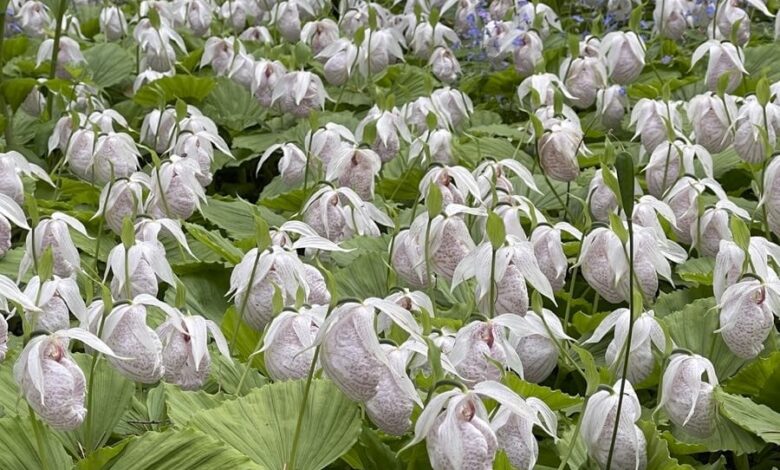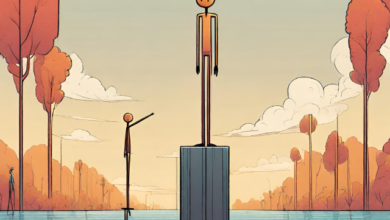
‘natural community gardening,’ with patrick mcmillan of heronswood
[ad_1]
I’VE BEEN LOOKING FORWARD to connecting with Patrick McMillan, who last October took over as director of the exceptional plant collection and astonishing landscape that is Heronswood Garden in Kingston, Washington.
Besides wanting to know what’s next there at a place that’s been known for a long time for its influence on American gardeners, Patrick has a personal passion I’m very curious about. It’s what he calls “natural community gardening,” as in taking our cues from habitats or plant communities in nature to guide how we design and care for our gardens.
Patrick came to Heronswood last fall from Clemson University in South Carolina, where he ran the South Carolina Botanical Garden and was a professor in the College of Agriculture, Forestry and Life Sciences. He also hosted a PBS series called “Expeditions with Patrick McMillan,” and led the development of the botanical garden’s Natural Heritage Garden. His motto, in his words:
“No matter how large a garden space is, no matter what you’re doing, you try to make your passion come to life on your piece of ground.”
Read along as you listen to the July 5, 2021 edition of my public-radio show and podcast using the player below. You can subscribe to all future editions on Apple Podcasts (iTunes) or Spotify or Stitcher (and browse my archive of podcasts here).
 natural community gardening with patrick mcmillan
natural community gardening with patrick mcmillan
Margaret Roach: So I feel like it must’ve been a bit of like, “Dorothy, we’re not in Kansas anymore” when you found yourself in the Pacific Northwest compared to South Carolina.
Patrick McMillan: It really was; it really still is. I’ve been a little shocked how quickly this area has started to just feel like home. Heronswood is one of the world’s great gardens, with some of the best garden people in the world. And the area itself also to me just has this wonderful kind of maternalness to. It seems to just envelop you, and convince you pretty quick that this is one of the best places on planet earth.
Margaret: Yeah. So, it’s a distinctively different natural community or habitat from where you were. And so besides being a shift in zone and so forth, it’s a distinguished place in many ways. Thousands of different types of plants and so forth, but also being I think one of the largest public gardens in the U.S. that’s wholly owned by a Native American tribe. Did that influence your decision to come there, and tell me a little bit about that?

And I said, “Oh, where is it?” And she said, “Heronswood.” We kind of came to a screeching halt. We were driving between our house in South Carolina and our home up in the mountains of North Carolina. And I had about three hours to put in an application. And to be honest, I have never applied for a job before [laughter]. I’ve always just moved from one position and off to the other.
And I put together that application very quickly because of what Heronswood is, the philosophy behind this place. And when I came and talked with the Tribal leaders here and the administration and the folks that work here, it just seemed to be a perfect match, because my worldview and the Port Gamble S’Klallam tribe’s worldview coincide.
And so it was partly, if not mostly, that real passion for life—promoting life, and understanding that every choice we make will have this profound reverberating effect out into the future forever here on this planet that really brought me here. And Dan Hinkley and his love of filling every space, which is so important to me, and making the most out of every little spot you have to provide color, to provide movement, diversity, life, odors—all those things that really make a garden, more than just statuary. It brings it to life. And so, yeah, that was the reason. And I can’t think of any other place that I would have gone in this country, aside from here. And it’s just been wonderful.
Margaret: And so you mentioned Dan Hinkley, and Dan was the director of the garden and was the co-founder of Heronswood Nursery that preceded the garden. Aand the garden today was the place that used to be their home, and so on and so forth. And a lot of us oldtime gardeners have many plants in their gardens that came mail order from Heronswood Nursery back in the day. The nursery doesn’t exist anymore, but anyway…and he’s a plant explorer. So, so many different layers there of excitement.
But natural community gardening, maybe tell us really quickly about the Natural Heritage Garden at Clemson that you were involved with, and so that sort of connector to where you are now.
Patrick: Yeah. So my background has always been gardening, but it’s also been rooted in ecology. So my PhD is in botany. But I’ve spent most of my life really caring about trying to keep America wild, to keep the world wild, to provide places where our plants, animals, and all the other things that give us the breadth of what life is, the experience of life, to keep those places going.
And so most of my life I’ve spent trying to understand how plants, animals, and humans interact in traditional ways in natural communities. And so when I got to the South Carolina Botanical Garden, I got there kind of in the middle of the economic downturn. And I took the position without pay for the first little bit just because it was put to me kind of like, well, either you can become director of the botanical garden, or we might consider closing it down. And I didn’t want that to happen.
So, I took the position, and I had no idea what I was doing. I went in and really had not had a close enough relationship with the botanical garden there in Clemson in the past, even though I’d been there for years. And very quickly, I started to see that the garden there had such a small staff, it tried to do things that other gardens were doing or had traditionally done, but it couldn’t go on the way that it was going on.
And so I got this idea that the only way to make something like this work is to take your passion and put it on the ground. And that’s what I say to every gardener, no matter how large a garden space is, no matter what you’re doing, you try to make your passion come to life on your piece of ground.
And for me, that was really trying to get people to understand beauty for what it is and redefine beauty. And for me, beauty lies in the intersections rather than the divisions of life. And there’s no place where our choices have a more profound and immediate impact than right in our own backyards. Because the choice of the way we plant, the choice of how much lawn we have, what we use in our landscape—that has a direct relationship to the layers of life and the intersections of life that happen within our garden and between us and all of those other living things around us.
So the idea for natural community gardening really was taking something that has become fashionable anyway, which is trying to mimic nature and doing provincial collections or collections that represent certain areas. And rather than just creating a collection of plants from the coastal plain, the Piedmont, and the mountains of South Carolina, what I decided to do was to try to bring all of the elements of a natural community into the garden. And we created this 64-acre exhibit. It takes folks from our mountain cove forests and mountain bogs all the way down to the maritime forests at the coastline. And we did it all in Clemson, South Carolina, which is hundreds of miles from the coast and nestled right up against the mountains.
When I started that project, there were a lot of naysayers [laughter], which I always… It’s fine. Failure is one of the greatest tools to help you learn. So I’m never afraid to fail, but I went into it head-first. It was really just my son and I that started the project because there was no staff to work on it. There was no money to really throw at it. And we just started doing and duplicating what I had learned from decades of working with natural communities into the garden.
So a natural community garden puts the soil type, the rock type, the geology, and the hydrology of the habitat together with the plants that occupy that habitat. And we arrange those plants in a way that we think they would be arranged in the natural community, and then sort of let them do their thing to rearrange themselves, and spend most of our time editing that landscape.
And then very importantly, we also input the human element. We input the traditional management practices into those habitats. So for our South Carolina Natural Heritage Garden, that meant burning our long-leaf pine flatwoods and wetlands savannah and our Piedmont prairie every single year. And what we were doing there is putting back into the habitat that traditional use of human beings of using fire to manipulate the habitat. Ultimately, it was always for human gain—to increase productivity, to increase the game that would be attracted to the area by the Native Americans that did this. And even today it continues in places like South Carolina. Keep the woods open, right? Provide habitat for things that folks like to hunt.
Margaret: But I don’t have to have a big place. 64 acres, I think you said. I don’t have to have that to think this way, right?
Patrick: No, no. And there are tiny examples of this, even in the natural world. Right here in the Puget Sound area in the Pacific Northwest, over in a little town called Port Townsend, there’s this wonderful little place it’s just a tiny little postage stamp called Kah Tai Prairie. And those traditional practices of keeping out woody vegetation using traditional means are on a very tiny piece of ground there. But the result has been this camas meadow, which is just full of Camassia there in springtime, has been perpetuated from the times that it was managed by Native Americans down to today.
And this practice can happen in a pot on your back porch. Duplicating and mimicking the patterns that we see in nature are the ways that you can generate the most biodiversity per square inch in our yard. And with the changing world, generating life as densely as we can in the back porches and the backyards of those of us who are gardeners is one of the most profound ways that we can actually be part of the answer, part of the cure to our declining biodiversity worldwide.
Margaret: Yeah. So each choice really that we make, both in plant selection, placement and aftercare, can promote this community, this reality of community.
Patrick: Absolutely. Absolutely. And so we can talk about some specific examples

Patrick: Right. And that’s one of the keys also to natural community gardening. And Claudia and Thomas has really brought that forward in their book, that they really took the time to get out and look at the way nature is. And nature doesn’t leave any space void. Something’s going to fill it. And so we can fill that with mulch, which is sort of the traditional…to me, still holding onto a bit of colonialism in America, which I find fascinating: that we’d rather control life as little round statuary shrubs or double-flowered plants that are widely spaced with a sea of mulch in between them.
And that’s wasting so much space that could be giving an adding to the life. So Step 1, really for this, is fill it. Fill it. Fill every space you possibly can with useful plants that work for a living.
And I love plants that work for a living. What I mean by working for a living is that they’re giving back something into the community. So, when we’re choosing trees for our yard, making sure we choose and put in trees that are supporting caterpillars, for instance. So oak trees obviously host more diversity and abundance of caterpillars than any other tree you can plant in North America. And that’s supported of course by Doug Tallamy’s research. But then filling all those spaces that you would use mulch in—filling all of those spaces with life.
So groundcovers and things that flower, but the things that flower and produce flowers that are usable by nature, which means avoiding double flowers. If you’re planting shrubs—and God knows, hydrangeas are the thing here in the Pacific Northwest—but planting a mophead hydrangea, you might as well just put a statue of a hydrangea up, because those that lack fertile flowers, they’re not providing any nectar or any pollen, which is absolutely essential for what’s been widely recognized as a worldwide crisis as a decline in our pollinators, much more than just honey bees, everything is declining.
So by planting a lacecap [above, a paniculata with lacecap flowers], or if you’re planting a paniculata variety, something like a ‘Kyushu’ that produces fertile flowers, rather than just mopheads that don’t offer anything back, can go a huge way to bringing waves of butterflies. Gosh, those paniculata ‘Kyushu’ hydrangeas at the South Carolina Botanical Garden become completely covered with tiger swallowtails in the late summer. And just the noise of all of the wasps and flies and bees and beetles that are attracted to that plant is amazing.
Margaret: And this is true, obviously, not just with hydrangeas, but when we go for the sort of ultra-decorator human-made version of a plant, even if it’s a native plant, where someone’s gone to breed it or select it for it’s the most double-fluffy-puffy flower of all, the insects can’t get at the assets, or there are no assets. And like you said, nectar and pollen and that’s gone too far. And so you’re saying we need to fill our spaces—because plants like to touch and tangle together and so forth in nature—and also fill it with vital resources.
Patrick: Yeah, yeah. Fill it with vital resources. And I love that, the touch and tangle thing, because it’s always fascinating to me that when we think about the places… And I always put it to people this way, if you’re thinking about the place where you feel closest and most connected with the world, the place that you go to find peace, most of us who are gardeners or are nature lovers, we’re going to think of a place that is the top of a mountain to me. Where I grew up in Allegheny County, North Carolina, where I’m sitting in this sea of prairie vegetation, tall-grass prairie vegetation on this mountain bald filled with Liatris and filled with Coreopsis. And looking down a rock outcrop that’s just alight with Hypericum and out over the Blue Ridge Escarpment.
It’s not a human-contrived landscape full of little round shrubs that I think of as the place that most connects me to the world. But when we make our gardens, we almost always go back and choose to make them things that are either statuary, like double flowers or this, that, and the other. And we want to have them cleanly separated from each other. And nature doesn’t do that.
And some of those most beautiful designs that really draw our hearts are those where the plants overlap. They overlap you, they touch you in the path, like they do here at Heronswood and one beautiful color bleeds into the other. And one contrasting foliage just overlaps and bleeds into the other. And that’s really we’re talking about—redefining beauty. It’s looking at relationships as one of the greatest lessons we can learn from our gardens.
The other really critical thing that is difficult for many of us is understanding that death also generates life.
Margaret: Yes.
Patrick: And that’s really important to me. So we are always, and this is, again, no matter if you’re in a pot or if you have 295 acres, death generates life. So deadheading many species of the plants removes one of their most important functions in the natural community.
Margaret: To produce seed. Yeah.
Patrick: Absolutely. So think about, obviously things that come to mind, like many of us grow Heliopsis, Helianthus—sunflowers. Those Coreopsis that we all know are really great bird food when they go to fruit. That’s an easy example to think of. But you may not realize that gaillardias are one of the best plants that you can put into your landscape and in the East and Southeast to draw in and feed goldfinches. And if we’re planting those and then taking off the flowers as they fade, that’s not going to happen.
So that’s difficult for some us [laughter] to have sort of a bit of unkemptness in our yards, and that extends to really tolerating and packaging brutal landscapes. The untamed parts, the back sections that we try to hide from the public in many of our public gardens, there’s places that are weedy and we haven’t developed yet. Those are critical.
Margaret: That’s where the action is, right?
Patrick: That’s where the action is. When you think about the butterflies that are in the Eastern U.S., when you think about things like buckeye butterflies, I mean, they lay their eggs on plantain. And so if we had a landscape without plantain… Snapdragons, they’ll lay their eggs on, too, but they’re gone by the time many butterflies might lay their eggs.
Margaret: We think of it as a weed. So I want to just now just transition quickly to the example of so Heronswood [above], again, maybe known to some listeners to me is a former source of rare plants. And it’s thousands of plant species and varieties in his collection from foreign lands where Dan Hinkley went plant exploring high up in the mountains and whatever. How do you make a natural community garden at Heronswood, then, with all that international diversity? So just tell us quickly a little bit about that connection.
Patrick: Sure. Well, the Woodland Garden [photo, top of page] essentially is a natural community garden. It just happens to combine things from all over the world. And, we’re all very careful here in our 9,000 species. When we start to see a plant that Dan may have introduced that is doing too well, it disappears from our landscape. I’m really impressed with how responsible they’ve been over the years doing that.
But we are getting ready to develop and really double the size of our Woodland Garden. So that garden area, our idea there is to create what we’re going to call the Traveler’s Garden. And it really takes us natural community garden concept and puts it on the ground here in the Pacific Northwest. And as far as I know, it will be the first example in a public garden here in the Pacific Northwest.
And in that garden, we will be illustrating a Western woodland garden, a true Western woodland garden, Cascadian habitats, serpentine barrens from the Siskiyous and Wenatchee mountains, and then middle- and high-elevation woodlands, places that you think are filled with balsam root and lupines in the springtime.
And then we also are incorporating what we’re calling the S’Klallam Connections Garden there, which is really a natural community garden that’s focused on where we are right here, just focused on the rain shadow forests of Kitsap County. And it’s being designed, it’s being interpreted, and the stories that are being shared about the connections between people and plants there, and people and all forms of life there, is all being done by our S’Klallam staff and volunteers from our S’Klallam community. So it is going onto the ground.
Margaret: That’s exciting.

Margaret: Wow [laughter].
Patrick: And then a garden really takes people into the footsteps of Dan Hinkley that is a Vietnamese habitat garden, not a Vietnamese collection, not a Chilean collection, not a Cascadian collection, but actually bringing all the elements of that natural community garden: the pretty things, the grasses, even the briars and the blackberries. So that folks really get an idea of what it’s like to be there, get immersed in the habitat. And it provides us yet another piece of this garden that will generate life
Margaret: Well, Patrick McMillan, congratulations again. And it’s so great—the team at Heronswood is unsurpassed. So it’s very exciting and I hope we’re going to talk more. And thank you for making time today. I’m sure you’re busy, busy, busy, but thank you for making time—and stay cool.
prefer the podcast version of the show?
MY WEEKLY public-radio show, rated a “top-5 garden podcast” by “The Guardian” newspaper in the UK, began its 11th year in March 2020. In 2016, the show won three silver medals for excellence from the Garden Writers Association. It’s produced at Robin Hood Radio, the smallest NPR station in the nation. Listen locally in the Hudson Valley (NY)-Berkshires (MA)-Litchfield Hills (CT) Mondays at 8:30 AM Eastern, rerun at 8:30 Saturdays. Or play the July 5, 2021 show using the player near the top of this transcript. You can subscribe to all future editions on iTunes/Apple Podcasts or Spotify or Stitcher (and browse my archive of podcasts here).
[ad_2]



 natural community gardening with patrick mcmillan
natural community gardening with patrick mcmillan




